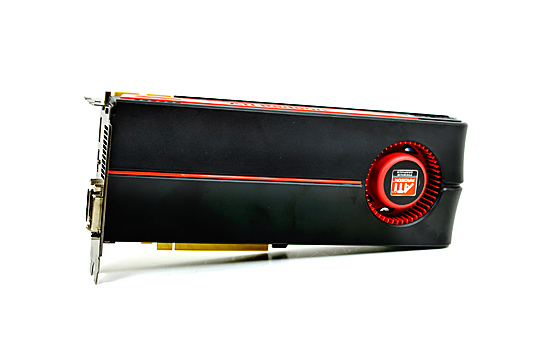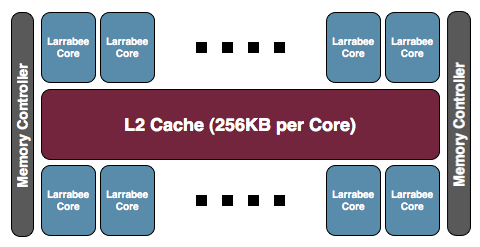Anand's Thoughts on Intel Canceling Larrabee Prime
by Anand Lal Shimpi on December 6, 2009 8:00 PM EST- Posted in
- GPUs
Larrabee is Dead, Long Live Larrabee
Intel just announced that the first incarnation of Larrabee won't be a consumer graphics card. In other words, next year you're not going to be able to purchase a Larrabee GPU and run games on it.
You're also not going to be able to buy a Larrabee card and run your HPC workloads on it either.
Instead, the first version of Larrabee will exclusively be for developers interested in playing around with the chip. And honestly, though disappointing, it doesn't really matter.

The Larrabee Update at Fall IDF 2009
Intel hasn't said much about why it was canceled other than it was behind schedule. Intel recently announced that an overclocked Larrabee was able to deliver peak performance of 1 teraflop. Something AMD was able to do in 2008 with the Radeon HD 4870. (Update: so it's not exactly comparable, the point being that Larrabee is outgunned given today's GPU offerings).
With the Radeon HD 5870 already at 2.7 TFLOPS peak, chances are that Larrabee wasn't going to be remotely competitive, even if it came out today. We all knew this, no one was expecting Intel to compete at the high end. Its agents have been quietly talking about the uselessness of > $200 GPUs for much of the past two years, indicating exactly where Intel views the market for Larrabee's first incarnation.
Thanks to AMD's aggressive rollout of the Radeon HD 5000 series, even at lower price points Larrabee wouldn't have been competitive - delayed or not.

I've got a general rule of thumb for Intel products. Around 4 - 6 months before an Intel CPU officially ships, Intel's partners will have it in hand and running at near-final speeds. Larrabee hasn't been let out of Intel hands, chances are that it's more than 6 months away at this point.
By then Intel wouldn't have been able to release Larrabee at any price point other than free. It'd be slower at games than sub $100 GPUs from AMD and NVIDIA, and there's no way that the first drivers wouldn't have some incompatibly issues. To make matters worse, Intel's 45nm process would stop looking so advanced by mid 2010. Thus the only option is to forgo making a profit on the first chips altogether rather than pull an NV30 or R600.
So where do we go from here? AMD and NVIDIA will continue to compete in the GPU space as they always have. If anything this announcement supports NVIDIA's claim that making these things is, ahem, difficult; even if you're the world's leading x86 CPU maker.
Do I believe the 48-core research announcement had anything to do with Larrabee's cancelation? Not really. The project came out of a different team within Intel. Intel Labs have worked on bits and pieces of technologies that will ultimately be used inside Larrabee, but the GPU team is quite different. Either way, the canceled Larrabee was a 32-core part.

A publicly available Larrabee graphics card at 32nm isn't guaranteed, either. Intel says they'll talk about the first Larrabee GPU sometime in 2010, which means we're looking at 2011 at the earliest. Given the timeframe I'd say that a 32nm Larrabee is likely but again, there are no guarantees.
It's not a huge financial loss to Intel. Intel still made tons of money all the while Larrabee's development was underway. Its 45nm fabs are old news and paid off. Intel wasn't going to make a lot of money off of Larrabee had it sold them on the market, definitely not enough to recoup the R&D investment, and as I just mentioned using Larrabee sales to pay off the fabs isn't necessary either. Financially it's not a problem, yet. If Larrabee never makes it to market, or fails to eventually be competitive, then it's a bigger problem. If heterogenous multicore is the future of desktop and mobile CPUs, Larrabee needs to succeed otherwise Intel's future will be in jeopardy. It's far too early to tell if that's worth worrying about.
One reader asked how this will impact Haswell. I don't believe it will, from what I can tell Haswell doesn't use Larrabee.
Intel has a different vision of the road to the CPU/GPU union. AMD's Fusion strategy combines CPU and GPU compute starting in 2011. Intel will have a single die with a CPU and GPU on it, but the GPU isn't expected to be used for much compute at that point. Intel's roadmap has the CPU and AVX units being used for the majority of vectorized floating point throughout 2011 and beyond.


Intel's vision for the future of x86 CPUs announced in 2005, surprisingly accurate
It's not until you get in the 2013 - 2015 range that Larrabee even comes into play. The Larrabee that makes it into those designs will look nothing like the retail chip that just got canceled.
Intel's announcement wasn't too surprising or devastating, it just makes things a bit less interesting.










75 Comments
View All Comments
MrPoletski - Wednesday, December 9, 2009 - link
Those major flaws that Intel pulled its SSDS for were ni reality fairly minor and unlikely to affect Joe Public.If it had been another company, the existance of a fault would probably have been denied completely.
Devo2007 - Monday, December 7, 2009 - link
Just to clarify: Intel SSDs are generally pretty good, but they have to run further tests on the firmware before releasing it.bradley - Monday, December 7, 2009 - link
Or how about substantiated claims about Intel's X25-E SSD having hardware/firmware problems which cause performance slowdowns and operational time-outs -- and at least one documented account of an enterprise storage provider who has kicked Intel to the curb, Pillar Data Systems Inc?http://www.computerworld.com/s/article/9138130/Pil...">http://www.computerworld.com/s/article/...SSD_to_t...
AnandThenMan - Monday, December 7, 2009 - link
This can't be taken seriously, really. Larrabee is a very very important product for Intel. Without it, they will have nothing to fight AMD and Nvidia in the inevitable HPC sector using some form of GPU acceleration. It's going to happen, which is why Larrabee was born in the first place. To say that "it doesn't matter" is asinine at best, of course it matters! It matters a whole hell of a lot, and the failure of Intel to make Larrabee a sellable and viable product is a huge setback, financially and otherwise. Intel didn't sink a vast amounts of money into Larrabee just to have it barely survive as some sort of developer platform. This was Intel's full on fray into making a real graphics chip.
How does Intel expect to fight Fusion now? They will have nothing that will come even remotely close. This whole article is a big fat attempt at trying to soften the blow, it's beyond silly and honestly fairly insulting to the readers. Sites like this are supposed to tell it like it is, and the truth is Larrabee is a giant, multi-billon dollar flop. Yes Intel can absorb it, but that doesn't make the failure any less significant in its own right.
AnandThenMan - Monday, December 7, 2009 - link
I would also like to add that AMD gets flogged and beaten with the point that they don't have a processor that can hang with Intel's best. But at least they have a processor that is fairly close. Turn things around, Intel has zero in graphics that can compete with AMD, yet Intel gets a pass.Intel should stop fooling around trying to make an x86 based graphics chip and design one properly, or buy up the IP to do it. Larrabee is essentially Intel trying to use x86 to monopolize the graphics space, but found out the hard way that x86 is terrible at doing graphics, the reason real GPUs exist it he first place.
beginner99 - Monday, December 7, 2009 - link
IMHO the are building this in x86 because sometime in the future you will just have the 100+ core array seen the Intel slides on which each core can be used for graphics or as CPU. So you actually don't have any distinction anymore between CPU and GPU.This would be pretty nice since the system can be balanced very nicely theoretically that your neither GPU nor CPU limited.
smartalco - Monday, December 7, 2009 - link
You seem to miss the part where Intel isn't canceling Larrabee as a consumer part permanently, they are just delaying consumer release. Pretty much everything you just said is irrelevant if you look past the one line you quoted.AnandThenMan - Monday, December 7, 2009 - link
Who cares? Something that exists in a lab or in obscurity for years on end doesn't do Intel any good, never mind the consumer. You can't buy Larrabee, and won't be able to for who knows how long, maybe never. Which makes it a failure, period. No amount of spin and excuses can change that. Apply the same logic to any other product, and say, well it's not available, won't be for years, but it doesn't matter it isn't actually canceled! All is well, nothing to worry about.
Pure nonsense. Suppose Fermi is never released, and Nvidia announces in 3 months that it won't be a real product, but will live on as an internal project. Will anyone really being saying, it doesn't matter? Of course not. The only reason Intel can get away with this is because it's not there core business. But that is going to hurt them going forward, because the GPU and CPU are on a collision course, it's only a matter time. Which again, is exactly the reason Larrabee was conceived in the first place.
Minion4Hire - Monday, December 7, 2009 - link
It does Intel a TON of good if they can get functional, realistic hardware into the hands of developers to play with and help them refine their product. I doubt Intel wants to release a part that no one is willing to buy because of the inevitable problems it will have upon launch, regardless of how well or poorly it performs. By holding back and letting the developers pick it apart they have more time to improve Larrabee and are more likely to be able to limit/counter the difficulties they will encounter when it's finally launched.AnandThenMan - Monday, December 7, 2009 - link
So you're saying up until this point, Intel had no Larrabee cards in the hand of developers?
You know what does even more good? Having and actual product on the market AND in the hands of developers. That's how hardware becomes successful.
How is holding back going to somehow magically make Intel able to improve Larrabee at a faster rate than they were working at before? It's not.